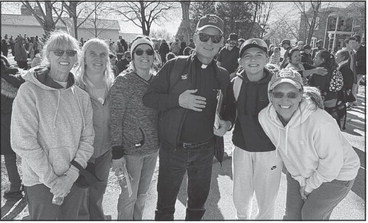Loyal council votes to send fluoride issue to the ballot
By Valorie Brecht After postponing a vote on the fluoridation of city water three times over the last six months, the Loyal Common Council decided to send the issue to the people through a binding referendum vote to be held next April. The decision took place at the council meeting held last week Tuesday.
In the initial public comment period, 10 people spoke opposing fluoridation while one person wanted to continue it. The people opposing fluoridation were Donna and Brian Milz (Donna read comments from Kathy Brock), Sadie Fitzgerald, Dave and Nancy Wucherpfennig, Jess Throckmorton, Pat Bell, Ken McEwen, Chenoa Christenson, and Shelly Saindon. Teresa Hall spoke in favor of fluoridation.
In addition, before the meeting, Loyal residents Steve and Alison Schley submitted a letter to the city opposing fluoridation. After the meeting, five local health professionals (Brittany Mews, Maryann Forsell, Jordyn Pieper, Ashley Kaiser, and Heidi Allen) submitted a letter to the TRG in support of fluoridation.
The main points brought up by those opposing fluoridation were a lack of informed consent, that the potential negative health effects outweigh the purported benefits, and that conversations and governmental action both on the national level and in local municipalities reflected a growing public awareness of the dangers of fluoride. Those in support of fluoridation said it provided a public health benefit that was especially important in preserving children’s dental health in a low-income area with less access to dental care, that fluoride was safe at the recommended levels, and it was recognized by several medical and dental associations as an effective oral health measure.
At the onset of the meeting, Mayor Carmen Englebretson announced that the council wouldn’t be making a decision on fluoridation that evening, because council member Greg Brock wasn’t in attendance and the council had previously decided they wanted the full council to weigh in on the issue. However, that did not prevent the council from discussing the issue in some detail during the utility committee portion of the meeting.
The council recognized that people were passionate about this topic and wanted an answer.
“I’ve had more people come to talk to me about this than anything else, both sides. So I’m very happy that people in my ward feel comfortable talking to me about it. The downside is it does put a heavy weight on us. It could be decided at the state or the federal level in the meantime here, but it is a big weight,” said council member Curtiss Lindner.
“The city workers do have hazmat suits and respirators to wear when they interact with it, so that tells you it’s not good,” said fellow council member Tim Froeba.
Newly-elected council member Gwen Klevgard said there was lots of information to support both sides online and it wasn’t a simple issue.
“Here’s the thing — you can research and research and find out more and more about it. I agree with what’s been said before, that the people should vote on it,” she said.
Council member Tom Bobrofsky asked when the next election would be, which city clerk Shannon Toufar said was April 2026, unless the city wanted to hold a special election, but that would be an added expense for the city. She estimated it would cost the city between $1,500 and $2,000 to run its own election, when including the costs to program the voting machine, print the ballots, pay the city and county poll workers, and pay postage for absentee ballots. There would also be the concern of not having as great a voter turnout if fluoride was the only issue on the ballot, versus if people were already visiting the polls for a state or federal election.
“I’m in favor of waiting that long (until April 2026),” said Bobrofsky.
“What stinks is that you guys have been very passionate in showing up at meetings,” said Lindner, gesturing to the residents in the room. “I’d like to have a definitive date to make a decision.”
“I make a motion to add it to the next ballot,” said
Please see Fluoride, page 11 Fluoride,
from p. 1
Klevgard. “I don’t feel I have the right to make the decision for everybody.”
After Klevgard made her motion, more discussion followed. Council member Kayla Schar said she would rather move forward with a decision and not keep people waiting. She said people had been vocal on this topic, with people visiting her office (she’s the Greenwood city clerk) and calling her at home to voice their opinions. She said of everyone she had talked to, only one person had expressed interest in keeping fluoride; the rest wanted to get rid of it. There was also a post put on a community Facebook page, with 15 people commenting they wanted the fluoride removed and only one wanting to keep it.
“At every council meeting I’ve been at, there’s been more people wanting to remove it than wanting to keep it. I guess, we’re elected to represent the people,” said Schar.
However, Hall commented that for those people who wanted to keep fluoride in the water, it may be difficult for them to speak out because they are going against the more vocal group.
“As a community business manager, I’m putting myself at risk saying that I want to keep it in,” she said.
After a bit more discussion, the council wanted to move forward with at least some type of decision and not keep the issue lingering.
“What if we put an end to it right now now and do a vote?” said council member Dave Geier. “The odds of us all being here for a meeting are not great.”
“It does feel like it’s a continuous pushing it off. Either we’re pushing it off till we’re all here or we’re pushing it off until April,” said council member Amanda Stephens.
However, in the end, the council settled on the idea that it was better to formally get the public’s opinion; that way they knew they would be doing what the majority wanted, especially since it has become such a contentious issue. After Stephens’ comment, Bobrofsky seconded Klevgard’s motion to put fluoridation on the ballot. The council voted 5-2 to put the issue on the April 2026 ballot, with Bobrofsky, Geier, Klevgard, Lindner, and Stephens voting in favor of the ballot measure; and Froeba and Schar voting against it.
The council had the option of making the vote binding or non-binding. They chose binding, which means the city must follow the results of what the people decide.
The council’s decision was not necessarily satisfying to all in attendance, especially those who have spoken at multiple meetings and seen the decision continually pushed back. The issue of putting fluoride in the water was first brought up at the Nov. 19, 2024, council meeting. At that time, the council voted to recommend the matter to the utility committee for further discussion. The utility committee met on Dec. 3 and sent the issue back to the full council because they felt the whole council needed to deliberate on it.
The full council met on Dec. 17 and decided to refer the matter back to the utility committee, have the utility committee come up with a way to get residents’ input on the matter, collect the data and bring it back to the full council in April for discussion. The utility committee did not come up with a definitive action step, but tossed around the idea of a referendum vote. At the April 15 council meeting, the council decided to table the fluoride issue, because a couple of council members were absent and they wanted to have input from the full council before making a decision. That was what led to the discussion at last week’s meeting and the decision to take it directly to the public.



